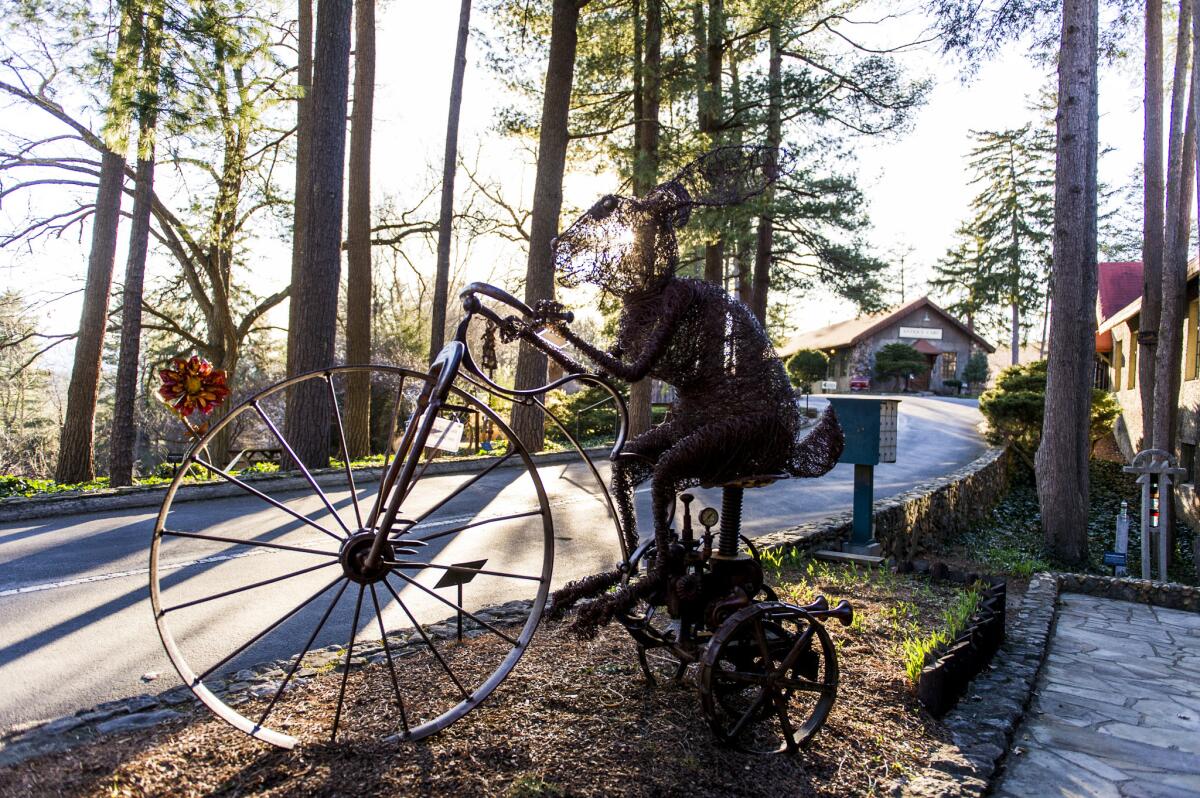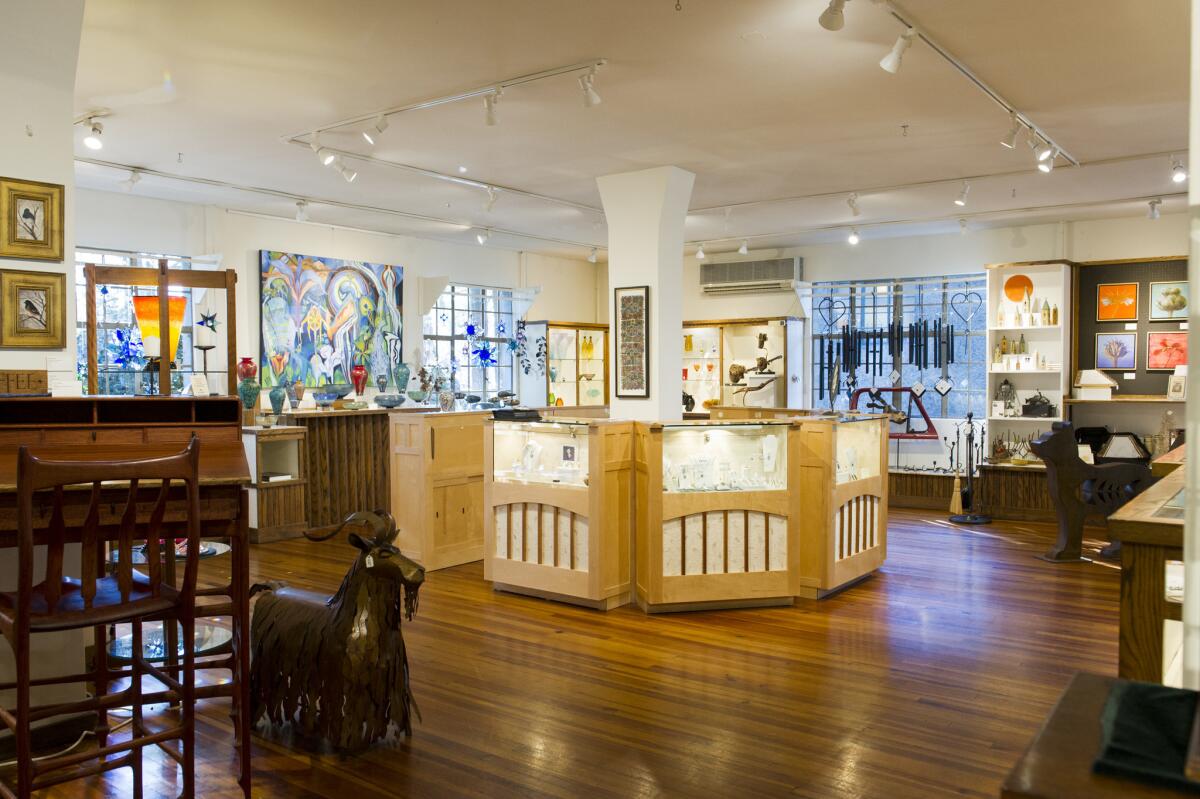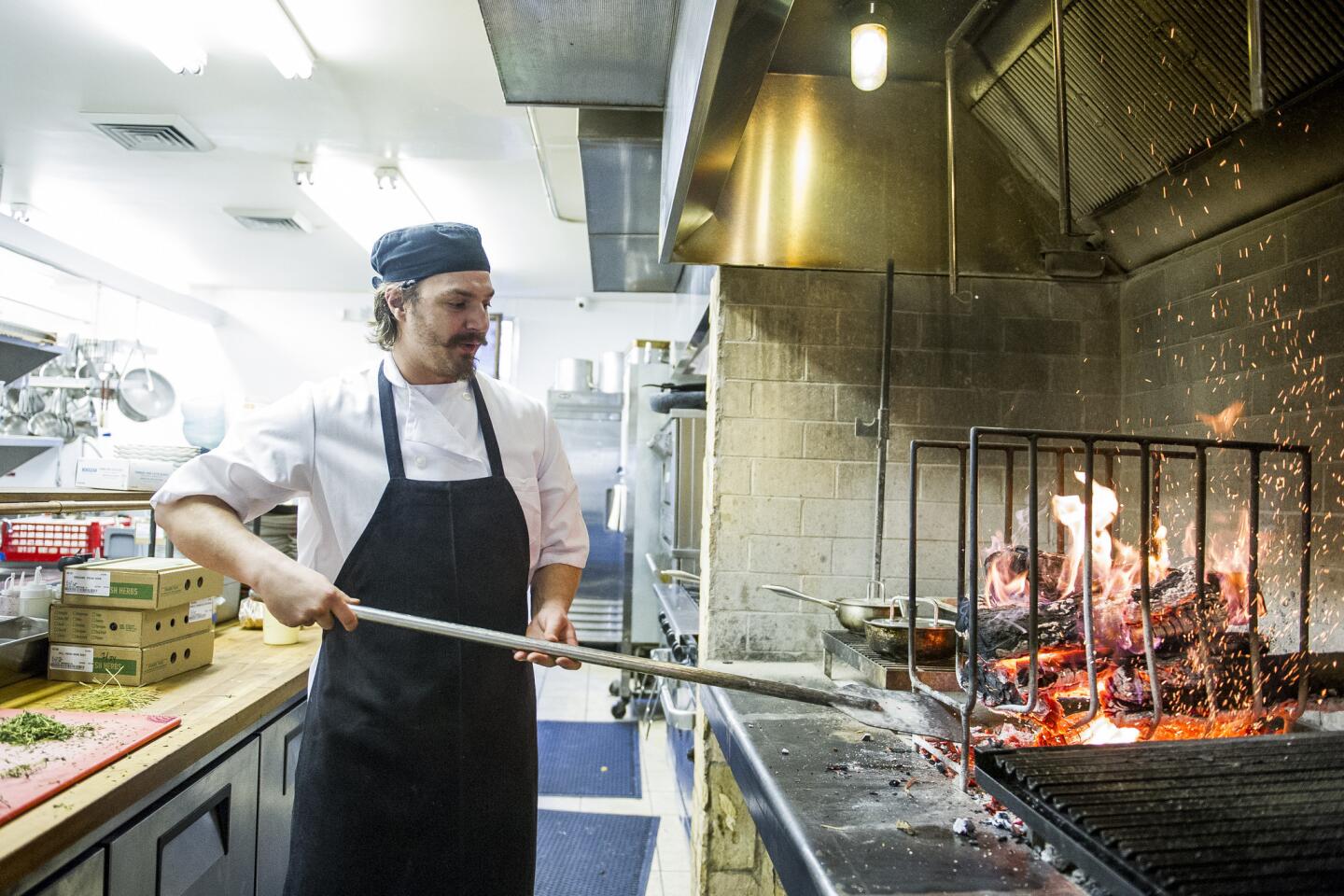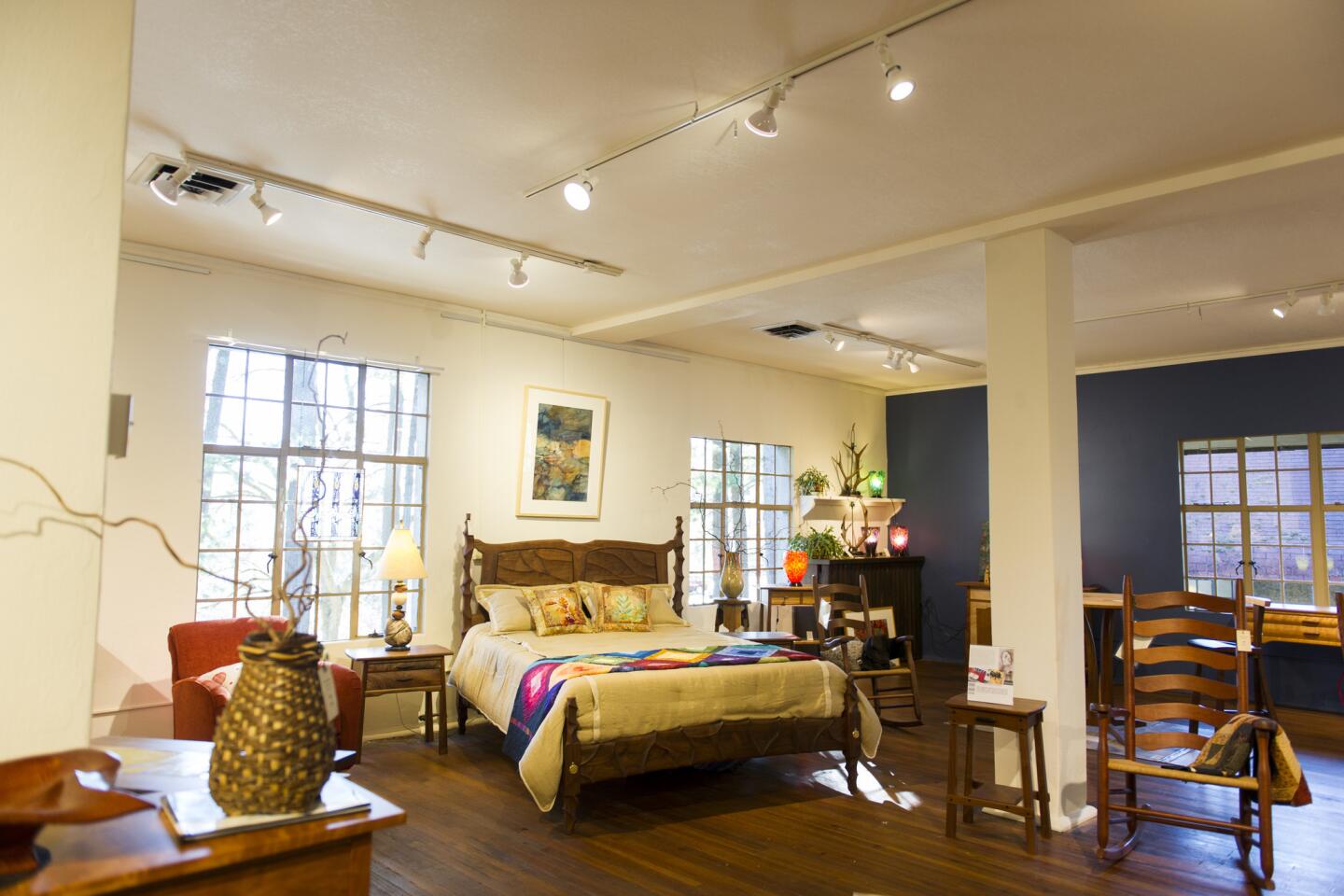Step into this hobbit-sized compound to glimpse Asheville, N.C.’s, artsy history
- Share via
Reporting from Asheville, N.C. — Of course you come to Asheville to see the 8,000-acre Biltmore Estate, America’s version of Downton Abbey. With about 1.4 million visitors a year, who doesn’t?
And of course you come to Asheville to ride the elevators hidden inside the massive fireplaces of the historic Omni Grove Park Inn. It’s the best way to get to the fourth floor, where F. Scott Fitzgerald once watched for pretty new guests from his hotel room window.
These are givens in this North Carolina mountain town of about 85,000.
But tucked behind a looming modern wing of the Grove Park Inn is an easy-to-miss but enchanting collection of Arts and Crafts-era buildings that give you a different look into the past.
This hobbit-sized compound, called Grovewood Village, houses two free museums, artists’ studios, an art gallery, an upscale restaurant and an outdoor sculpture garden nestled among the pines.
The Grovewood Gallery features work by accomplished artisans, such as Benjamin Rosenberg’s elegant walnut-and-maple chair ($1,100) and Dale Rogers’ whimsical outdoor sculpture of three cardinals in a tree (“Spring Awakening,” $3,750).
Great art is a given in Asheville, which has at least four distinct arts districts, including the River Arts District, which features about 200 artists.

What elevates Grovewood Village to must-see status is an unmarked building behind the gallery and the studios. It’s a ghostly remnant of a factory that, in the 1930s, was the world’s largest producer of hand-woven wool.
Inside its concrete walls, covered in peeling gray paint, are rows of abandoned looms, forgotten spools of thread, empty dye vats, piles of burlap bags stamped “property of Biltmore Industries” and room radiators gone cold for nearly four decades.
Walking into the Dye House is like walking into a cracked, sepia photograph.
“It’s a dank and dark old building,” said Tom Anders, the Grovewood’s museum manager. “But it’s pretty cool. … I’ve had photographers in there who wanted to take pictures all day as the light changes on the machinery.”
The stories of Grovewood and the Grove Park Inn have been intertwined since 1917, when Fred Seely, the inn’s general contractor and son-in-law of founder Edwin Grove, bought Biltmore Estate Industries from Edith Vanderbilt, widow of George Vanderbilt II, who built the Biltmore Estate.
The “industries” were a small collection of local woodworkers and weavers, a hobby of sorts for the Vanderbilts.
Seely moved the small enterprise from just outside the Biltmore mansion to the newly built complex beside the inn and dropped the word “estate” from the name.
For the next 63 years, except for a postwar break from 1949 to 1953, the Industries created homespun wool fabrics for high-end customers until changing styles and technologies brought the business to a close in 1980.
At its peak, the industries had as many as 100 weavers working 45 hand looms and, according to one gushing newspaper account from 1934, “If there is anything in the world that can produce a better wool than is produced by Biltmore Industries, they do not know what it is.”

The one-room, low-key North Carolina Homespun Museum at Grovewood documents all this with bolts of wool, fabric samples, suit jackets and vintage photos with captions explaining the process and history.
The change from moribund factory to lively arts compound began in 1992 with the opening of the Grovewood Gallery by the property’s owners, Marilyn Blomberg Patton and Barbara Blomberg.
Since then, Grovewood Village (which no longer is financially connected to the Grove Park Inn) has added an antique car museum housed in a building once filled with weavers; the Homespun Museum, with studio space for nine local artists; and the Golden Fleece Slow Earth Kitchen, a new Mediterranean restaurant.
Grovewood doesn’t do much to advertise the former Dye House; it wasn’t even noted on a map my wife and I used to explore the complex. We discovered it while chatting with resident artist Kathleen Doyle, who with her husband, Tom Reardon, has crafted jewelry and intricate metal work for 40 years.
Doyle happened to mention the building’s hidden wonders and told us not to miss it. Good advice.
From April through December, Grovewood offers a free, 45-minute history tour at 1 p.m. Wednesdays and Saturdays. If you can’t make it to one of the official tours, you can call ahead, and Anders will show you around and add the historical details, such as the fact that Seely paid Vanderbilt a $10,000 licensing fee for the Biltmore Industries name; that weavers were paid both an hourly wage and by the amount they weaved — about 30 yards a week on average; and that most of the machinery in the building was designed and built in the 1920s.
“We don’t do a thing to it,” Anders said. “Most of the lightbulbs are now out. But I’ve had people tell me they’ve been to the Biltmore and told me they enjoyed this more.”
If you go
THE BEST WAY TO ASHEVILLE, N.C.
From LAX, Delta, United and American offer connecting service (change of planes) to Asheville. Restricted round-trip fares from $412, including taxes and fees.
WHAT TO SEE
Grovewood Village, 111 Grovewood Road, Asheville; (828) 253-7651, www.grovewood.com. The former Biltmore Industries celebrates its centennial June 17. Activities will include a fiber art exhibition, guided history tours, artist demonstrations and a cake-cutting ceremony. Arts and crafts historian Bruce Johnson will be a guest speaker.
Grovewood Gallery, (828) 253-7651, turns 25 and a celebration is planned for May 20. It will include an outdoor sculpture exhibition, artist demonstrations, live music and local food. Open 10 a.m. to 5:30 p.m. Mondays-Saturdays, 11 a.m. to 5 p.m. Sundays.
Estes-Winn Antique Car Museum, North Carolina Homespun Museum and the Dye House: Open 10 a.m. to 5:30 p.m. Mondays-Saturdays, 11 a.m. to 5 p.m. Sundays, April through December.
Artist studios: Hours vary depending on the artist. Appointments can be scheduled through Grovewood Gallery or by contacting the artists. The studios are open to the public from 11 a.m. to 4 p.m. every third Saturday from May to November.

Golden Fleece Slow Earth Kitchen, 111 Grovewood Road, Asheville; (828) 424-7655, goldenfleeceasheville.com. Open for lunch 11 a.m. to 3 p.m. Tuesdays-Saturdays. Dinner 5 to 9 p.m. Tuesdays-Thursdays and Sundays; 5 to 10 p.m. Fridays and Saturdays. Brunch 10:30 a.m. to 3 p.m. Sundays.
More to Read
Sign up for The Wild
We’ll help you find the best places to hike, bike and run, as well as the perfect silent spots for meditation and yoga.
You may occasionally receive promotional content from the Los Angeles Times.

















